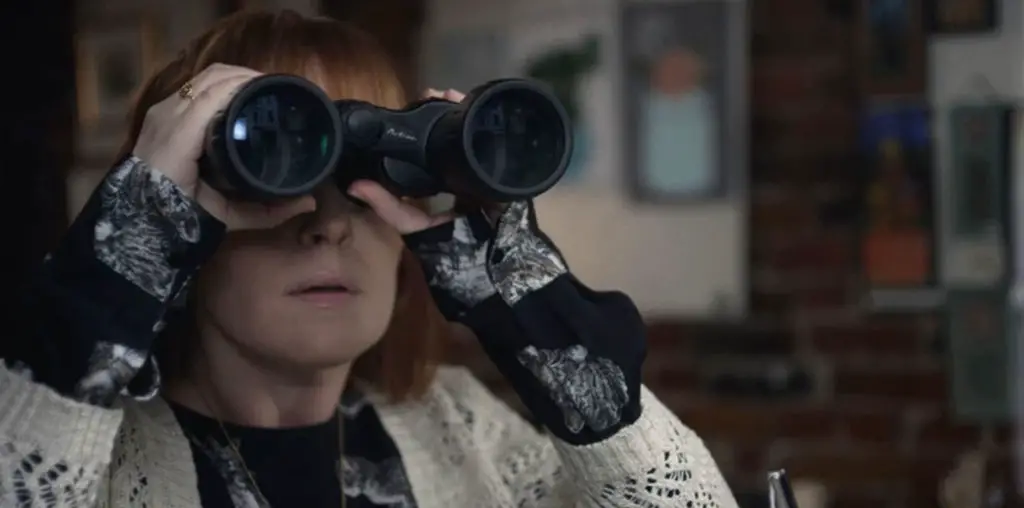
Raheem tells Mookie that there are no two ways about it. “If I love you I love you, but if I hate you I hate you.” Every issue is black and white to Raheem and if you are on the wrong side the message is clear that you had better be ready to fight. If Mookie is to be his friend he has to be on his side.
Raheem is next shown in a confrontation, with a group of Latino’s. Rather than share the music of their two cultures and grow, the two try to drown each other out. Raheem’s victory is not based on anything more than the power of his huge radio.
During the playful fire hydrant scene, Raheem appears as if Moses parting the Red Sea. The youth of the neighborhood separate and let Raheem by not out of respect for his radio’s aversion to water, but seemingly out of fear for his size, power and cool. Something they do not hold for the white motorist unlucky enough to follow him.
It is at this point that we meet Raheem’s symmetrical counterpoint in the visage of a huge racist white cop, who tells the people he has been appointed to protect and that if anyone gets out of line they will have to deal with him. The only difference between Raheem and the cop is their skin color. Both are intolerant to people different from themselves, and both exist as a function of their strength and power. They are the same flawed people, whose personality and identity are fixed, by what should be the meaningless difference in the color of his skin. It is at the hands of this cop that Raheem dies in the crucifixion like chokehold grasp of his white alter ego. His death over a radio is a tragic waste, but it is almost fated by the conflict of these two characters, which are easily the most radically intolerant in the movie. The playful early scene where Raheem proudly proclaims that hate has been KO’d by love, culminates in Raheem’s lifeless body, laid out in much the same position as Tommy Smith’s black gloved posture on the medal stand of the 1968 Olympics, only here the lifeless body holds up only the hand of the hate that killed him spelled out in the gold, indicative of his misguided life.
One of the interracial friendships that does exist is the one between Mookie and Richard Edson’s character Vito. Vito prefers Mookie to his brother Pino, because “he listens to me and you don’t.” Pino though overtly racist is still allowed by Lee time to be heard sympathetically and in his own words. He is given reasons for his hostility towards the place “he detests like a sickness.” It may even be suggested that in a world that has chosen hate over love that Pino is the most self realized character in the movie. He tells Vito to remember who he is and that Mookie is not to be trusted, a prediction that is realized by Mookie’s final decision.
According to Lee, the obvious best solution is for everyone to disregard their differences, be tolerant and get along. Unilaterally Lee is calling for his people to do what they can to have the upper hand morally, as King preached, while raising themselves up to a level that is better able to compete for respect through economic and intellectual power as suggested by Malcolm X. Like Malcolm X, Spike will not rule out violence, but anyone who watches “Do The Right Thing” intelligently can’t help but see his sadness at what he sees to be inevitable conflict.
From the other side of the fence though is Mister Senior Love Daddy. Because he is self aware and tolerant he sees no problem with Mookie’s friendship with Pino. The same cannot be said for Buggin’ Out, who has to be told by Mookie that Pino is “down.” Nonetheless he intolerantly warns Mookie to “stay black”.
In Buggin’ Out’s key confrontation with Sal, he argues that it’s a free country. The exact same argument is made seconds later to Buggin’ Out by John Savage, the white man in the Larry Bird jersey whose bicycle accidentally runs over his new Air Jordans. With the tables turned Buggin’ Out sadly yet humorously chalks the notion up as nonsense.
The movie’s message is not the riot at the end. The riot is only the sad result of the path not taken. The path that is taken by the older wiser characters played by Ruby Dee and Ossie Davis. At the film’s onset Dee and Davis are so at odds that they are both filmed at opposing angles. When Ossie Davis’ Da Mayor does a nice thing by buying Dee’s Mother Sister some flowers the characters stop being filmed at opposing angles. When Dee accepts Davis’ kindness and praises Da Mayor for saving a boy from being hit in traffic, Lee lets you know that this is the right path by illuminating a street light over Davis’ head. If you’re not convinced by this point listen carefully to the soundtrack because a little bell literally goes off. The message of the film is in that bell going off, but because it was stuck in the middle of the film and followed by violence it was sadly ignored.
The film’s right thing to do is to get along despite our differences. Sadly everyone was too concerned with their own point of view to see that Mookie’s actions were the only course acceptable to a world that insists that you choose one side or the other.
Check out FILMTHREAT.com’s FEATURE ARCHIVES and read more insightful stories, expert analysis, gut-busting satire and caustic commentary!
